|
This month there are some fantastic stars to see!
Some people say that the late autumn night sky is very dull but that's only because they don't know what to look for. Of course the circumpolar stars, the stars that circle the pole, are still there.
The Big Dipper is obvious but you'll need a good (moonless and cloudless)
night to see all the stars that make up the Little Dipper. Regardless,
even on an average night you can find Polaris in the end of the
Little Dipper's handle by using Merak and Dubhe as pointers to
it.
The Great Summer Triangle, made of the three bright stars Vega, Deneb and Altair, is also pretty obvious. In November, soon after sunset, you can find the Great Summer Triangle directly overhead.
By the way, neither the Dippers nor the Triangle are true constellations.
The International Astronomical Union recognizes only 88 constellations
and they are all named after mythical characters or inanimate
objects.
| 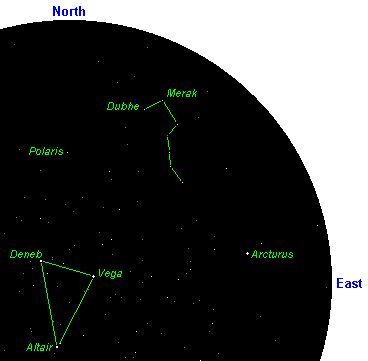 |
When people talk about constellations, the Zodiac comes to mind.
The Zodiac is a series of constellations positioned along the
same plane as the Earth's orbit so the Sun and planets seem to
travel through them. There are a dozen Zodiac constellations and six are visible
soon after sunset this month. They form a line that at this time
of year runs from the south west to the northeast. Let's identify
them.
(I've removed the planets from this series of images in order to get you to think about the stars. Refer to the monthly sky map, near the end of this page, for the complete picture.)
|
Low on the southwest horizon immediately after sunset is a large beautiful constellation
called Scorpius. It's a giant scorpion with a complicated curved
tail. The most obvious feature in Scorpius is the bright red star
Antares in the scorpion's "heart".
Behind Scorpius, just to the west, is another easy constellation, Sagittarius This is supposed to be an archer but he looks like a teapot to me. The teapot is pouring onto the scorpion's tail. | 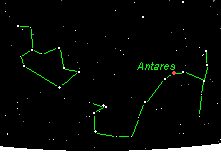 |
On a clear moonless night look carefully at the spout of Sagittarius'
teapot and you will see steam rising out of it!  No kidding. This
"steam" is actually the Milky Way and it extends all
the way up through the Great Summer Triangle.
No kidding. This
"steam" is actually the Milky Way and it extends all
the way up through the Great Summer Triangle.
|
Finding the next four constellations is trickier but not impossible.
Use the Great Summer Triangle as a pointer.
Following Capricornus is the next member of the Zodiac - Aquarius, the Water Bearer. This is a very dim constellation (it has no stars brighter than the 3rd magnitude) and easy to miss so find it by first finding Capricornus and then moving slightly east (left) and north (up). I think Aquarius looks like a "stick figure" of a person reaching towards Capricornus.
| 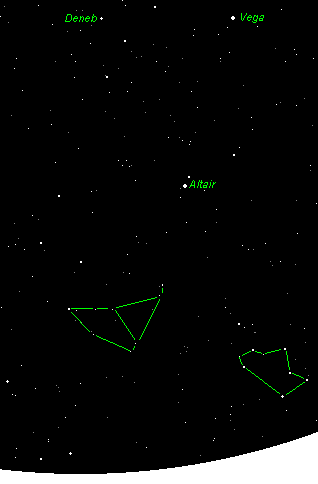 |
Once you're satisfied that you've found Aquarius, follow the Zodiac eastward and slightly northward to Pisces, the Fishes. This is a large but rather dim constellation. However, it contains the useful asterism called the "Circlet of Pisces". If you look just to the east (left) of Aquarius you will see an imperfect circle of stars. That's your clue to Pisces.
|
Sweep eastward from that loop following the brighter stars in a long
arc that ends at the brightest star in Pisces, alpha-Pisces. Granted,
this isn't all that bright a star with a magnitude of 3.8 but
it's the point in Pisces at which you imagine the line now turning
north. The entire constellation is supposed to be two fish but
I think it looks more like a cowboy's lariat.
Following Pisces is the dull zodiac constellation of Aries, the Ram. It's a very small constellation and only its brightest star, Hamal (magnitude 2.0) helps you to find it. Sheratan is Hamal's partner. | 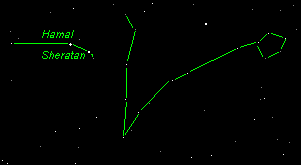 |
There you have it - half the Zodiac is just waiting to be seen by you. If you stay up late enough the other Zodiac constellations would follow. After Aries comes Taurus (the Bull), Gemini (the Twins), Cancer (the Crab) and Leo (the Lion). By around sunrise Virgo (the Virgin) should begin to appear but the Sun blocks your view of most of it. Libra (the Scales) is also obscured by the Sun. As the year goes by the Sun will appear to move through the Zodiac spending about one month in each. That one month isn't exact. Libra is a very small constellation so the Sun passes through it much more quickly than it does through the huge constellations of Scorpius or Pisces.
Many superstitious people believe that your personality and future
are determined by which Zodiac constellation was hidden by the Sun, and
the position of the planets (in the Zodiac), on the day you were
born! I hope you enjoy the Zodiac for the beauty it provides and
not to prop up a superstition. Remember - your future is not determined
by such silly things as the Zodiac. Your future depends upon YOU
- what you do and what you learn. I hope you will learn these
six Zodiac signs and enjoy your future. 
The Taurids meteor shower reaches its peak on November 3rd but you'll see less than ten an hour. Not very impressive. These meteors are the "offspring" of Comet Encke - a frequent short-period comet well known to the comet hunting fraternity.
The Leonids should be more interesting. This meteor shower is caused by the remains of the comet Tempel-Tuttle and the debris has not yet been distributed evenly around its path. Every 33 years the bulk of the remains sweep across the Earth's orbit at the same time the Earth sweeps through the debris ring. The Leonids meteor showers were particularly spectacular in 1966 so we expected a good show this time around, centered on the years 1999 and 2000. Last year the owners of orbiting satellites, as well as astronauts and cosmonauts, were on their toes expecting a heavy meteor storm. The showers were very good (heavy) but the space industry managed OK. Let's see what happens this time around. The Leonids last only a few days, starting around November 15, peaking on the 17th and tailing off by the 19th.
|
Your sky map for the month of NovemberHere's a map of the clear, night sky as seen from the center of the USA on the first evening of this month, an hour after sunset. Specifically, this is the view of a clear sky from a latitude of 37N. Star-gazers farther north, such as in Minneapolis, Chicago and most of Europe, will have more of the northern sky visible and the southern sky will be obscured by the horizon. Vice versa for those who are farther south. The stars will not change position relative to each other, however, throughout the month, the Moon and planets will wander, so they are not shown. Only objects of magnitude 4.0 and brighter are displayed. Here's a reverse color image of the map that will be easier on your printer. | 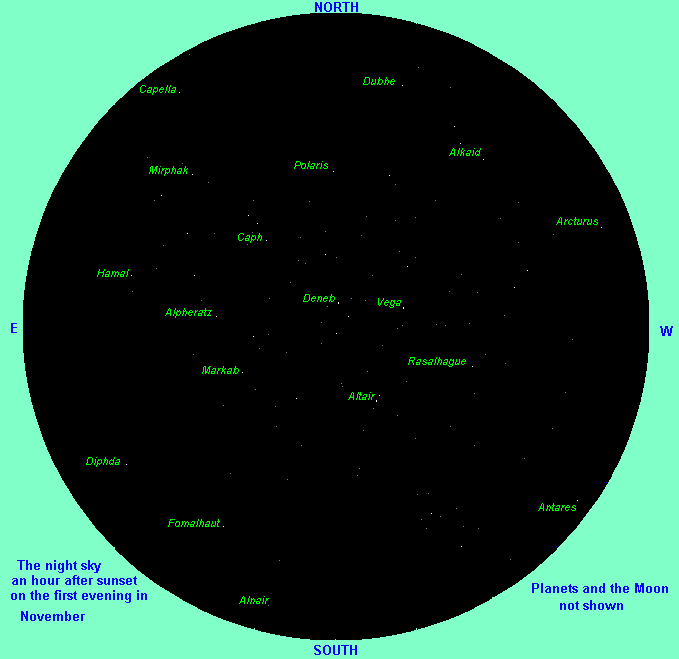 |
On November 30, 1954 Elizabeth Ann Hodges was enjoying a nap in
Sylacauga, Alabama when she was hit by a 5 kg meteorite!  She suffered
a bruised hip.
She suffered
a bruised hip.
The first Earthling in space, a dog named Laika, was placed into
orbit by the USSR aboard Sputnik 2 on November 3rd 1957.
(About a month earlier, on October 4th, Sputnik 1 became
the first man-made object in orbit.) There was no plan to bring
Laika back so she also became the first Earthling to
die in space. 
The USA space probe Mariner 9 become the first man-made object to orbit Mars on November 13, 1971. This mission forever changed our view of the red planet. It had been estimated that the air pressure on the Martian surface would be about 87 millibars but Mariner 9 showed it to be less than 10 millibars. We expected the Martian atmosphere to be mostly nitrogen, like our own, but it turned out to be mostly carbon dioxide. The polar ice caps were not the water ice we had expected but mostly "dry ice" (frozen carbon dioxide). Mariner 9 sent back over 7,000 photos of the red planet during the next eleven months giving us detailed images of the Martian surface that we now take for granted.
On the night of the 1st of November 1977 Charles Kowal discovered Chiron. This icy asteroid was the first of a population of icy objects orbiting in the outer Solar System.
I hope you found the Night Sky this Month to be helpful and educational. I invite you to return here monthly for new information.